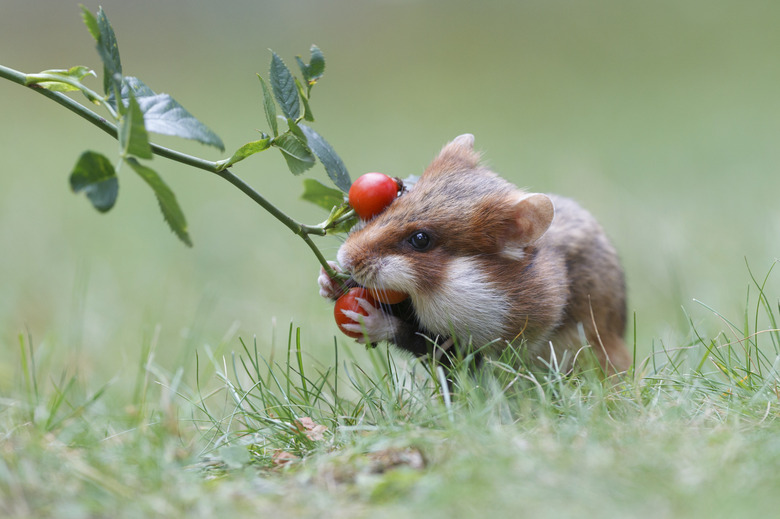What Animals Commonly Eat Hamsters In The Wild?
Hamsters are a type of rodent in the subfamily Cricetinae (family Cricetidae). There are multiple different species of hamsters. The golden hamster, Mesocricetus auratus, is the most common pet species.
Many people have fond memories of their hamster pet and tend to forget about hamsters living in the wild. Like all domesticated animals, hamsters were initially sourced from wild populations.
Hamster Life Cycle
Hamster Life Cycle
The hamster lifespan is typically two to four years. At six to eight weeks, hamsters are sexually mature. A female hamster has between two and four litters a year with different mates. Pregnancy lasts between 15 and 22 days.
On average, each litter consists of six babies. However, litters can be as large as 13, meaning hamsters can produce up to 30 offspring per year. Females raise the young alone and nurse them off her care at around three weeks old.
Where Do Hamsters Come From?
Where Do Hamsters Come From?
Hamsters are found in what is known as the Palearctic range. The Palearctic range spans eastern Europe, Syria, Iran, Mongolia, Siberia, Asia Minor, northern China and Korea.
The beloved golden hamster pets are of Syrian origin.
What Is a Hamster's Natural Habitat?
What Is a Hamster's Natural Habitat?
In the wild, hamsters naturally live in very dry, open areas such as deserts, dunes, shrublands, rocky areas and river valleys. These environments can be hot during the day and summer, and cold at night and winter.
Hamsters can also be found living in gardens, orchards and agricultural fields. Hamsters dig extensive interconnected paths and burrows to live in, store food, raise young and hibernate.
How Do Wild Hamsters Fit Into the Food Web?
How Do Wild Hamsters Fit Into the Food Web?
Like other rodents, hamsters are omnivores. The majority of a hamster's diet is made up of grains. Hamsters also eat fruit, roots, seeds, leaves, invertebrates and sometimes smaller mammals, frogs and lizards.
Hamsters can be seen stuffing their cheek pouches full of food and taking it back to their burrows for storage.
Animals That Commonly Eat Hamsters in the Wild
Animals That Commonly Eat Hamsters in the Wild
Being small mammals, hamsters often fall prey to larger omnivores and carnivores. Who eats them will vary depending on the species and where they live. Common predators of hamsters in the wild include snakes, birds of prey and predatory mammals.
Though small, hamsters will defend themselves using their large incisors, and females will carry young away to safety in her cheek pouches.
Snakes
Snakes
Hamsters are prey for snakes that are large enough to eat them. Snakes will select prey that is smaller than their jaws to swallow them whole. Snakes primarily use scent to find their prey.
Birds of Prey
Birds of Prey
Hamsters can fall prey to birds of prey such as red kites (Milvus milvus), black kites (Milvus migrans), common buzzards (Buteo buteo), eagle owls (Bubo bubo) and the lesser spotted eagle (Clanga pomarina). Smaller juvenile hamsters may also become food for common kestrals (Falco tinnunculus), grey herons (Ardea cinerea), carrion crows (Corvus corone) or rooks (Corvus frugilegus).
Birds of prey use their keen eyesight to identify and capture their prey. Hamsters' mottled fur helps them to blend into their environment and hide from bird predators.
Mammals
Mammals
Larger predatory mammals such as red foxes (Vulpes vulpes), ermine or stoats (Mustela erminea), badgers (Meles meles) and canines hunt hamsters.
Domesticated cats and dogs also hunt wild hamsters that live in or close to areas of human habitation. Hamsters are active at night and stay in their burrows during the day in an attempt to avoid predators.
Humans
Humans
Humans are a common cause of wild hamster mortality. Throughout history, humans have hunted these tiny creatures for their fur or trapped them to protect crops. Roadkill is also a common human-related cause of hamster death.
Cite This Article
MLA
Jerrett, Adrianne. "What Animals Commonly Eat Hamsters In The Wild?" sciencing.com, https://www.sciencing.com/animals-commonly-eat-hamsters-wild-8467984/. 22 November 2019.
APA
Jerrett, Adrianne. (2019, November 22). What Animals Commonly Eat Hamsters In The Wild?. sciencing.com. Retrieved from https://www.sciencing.com/animals-commonly-eat-hamsters-wild-8467984/
Chicago
Jerrett, Adrianne. What Animals Commonly Eat Hamsters In The Wild? last modified March 24, 2022. https://www.sciencing.com/animals-commonly-eat-hamsters-wild-8467984/
